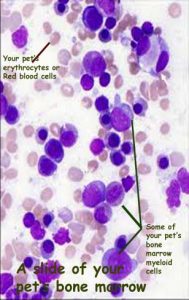Your Dog Or Your Cat’s Bone Marrow Myeloid/Erythroid ME Ratio
Ron Hines DVM PhD
Your Pet’s Myeloid To Erythroid Cell Ratio = M:E ratio, (Of A Bone Marrow Sample)
Your dog and cat’s White Blood Cell (= leukocyte) Count and red blood cell (= erythrocyte) count are both the result of what is occurring in its bone marrow. Since none of the blood cells that circulate in your cat or dog’s circulation have a very long life, the bone marrow activity that generates them is reflected in your pet’s blood stream rather quickly.
The only blood cells that do not always originate in your dog or cat’s bone marrow are its lymphocytes – those also have the ability to divide and proliferate in its lymph nodes, spleen and thymus gland. In dogs and cats, those are also the ones most likely to become cancerous.
When the diagnostic laboratory reports, or your veterinarian’s in-house blood analyzer results indicate that your pet’s circulating white blood cell numbers (WBCs) or their characteristics (morphology) are unusual and your veterinarian’s physical examination does not indicate the cause, your vet might consider this M:E ratio test to be an appropriate next step.
That would be even more likely the case if cells that belong in your cat and dog’s bone marrow are found circulating around in its blood. Closely examining what is going on in your pet’s bone marrow “factory” is a logical decision whenever that occurs.
Other specific reasons an M:E test might be ordered are unexplained (non-regenerative) anemia, unexplained bleeding (thrombocytopenia), or a lack of one or more classes of white blood cells that should have been in your pet’s blood but weren’t. An overabundance of a single cell type without a good explanation why is another excellent reason to run the M:E test.
Repeated, unexplained fevers or infections, or a lack of expected response to therapy might also indicate that an M:E test is desirable.
When veterinary pathologists examine the bone marrow samples of your dog or cat that were submitted by your veterinarian, they look for abnormalities in the “founding” cells (=progenitor cells, myeloid cells, stem cells) that produce the white blood cells and the “founding” cells (=erythroid cells, erythroid precursor cells) that produce the red blood cells. They also compare the number of each to the other, looking for an overabundance (too many) of any one type.
Reasons Why Your Dog or Cat’s Myeloid:Erythroid Ratio Might Be Abnormal:
In mature and older dogs and cats, leukemia (cancer) of one of the cell lines in your pet’s bone marrow is a common cause of abnormal M:E test results. Those situations go by multiple complex names. Some are actually precancerous (hyperplastic) states (situations) rather than cancerous states. The progress of these types of bone marrow issues is highly unpredictable. Precancerous states might at some point morph into overt cancer – or they might not.
Some in this group are: Myeloid leukemia, multiple myeloma, myelodysplastic syndrome (MDS), defective blood platelet production in cats (dysthrombopoiesis is often associated with the feline leukemia virus), eosinophilic leukemia and myeloid metaplasia. Infection with the feline immunodeficiency virus can account for abnormal M:E results as well. (read here)
Parvovirus infection in dogs and panleukopenia virus infection in cats can also result in abnormal M:E results. Severe cases of ehrlichia parasites in dogs or haemobartonella infection in cats and autoimmune diseases directed at the pet’s own bone marrow can also affect your dog or cat’s M:E ratio.
Certain medications can affect your pet’s M:E ratios:
Those medications are known to include trimethoprim/sulfa and chloramphenicol antibiotics. Methimazole medication prescribed for hyperthyroid cats has also been associated with alterations in M:E ratio. Albendazole wormer, given to treat intestinal parasites, phenobarbital dispensed for epileptic seizures, and griseofulvin given to treat ringworm fungus have all been known to alter M:E ratios in dogs and cats.
Estrogens given to abort a pregnancy (the infamous “mismate” shot or jab) or situations when a pet naturally produces too much estrogen can also alter M:E ratios. Sertoli cell tumors in male dogs can have the same effect. (read here)
Other Causes:
Deficiencies in folate or vitamin B12 can also be the underlying cause of abnormal M:E ratios. So can chronic blood loss anemia.
Gray collies with a condition called cyclic hematopoiesis, dogs with congenital (born with) dyserythropoiesis (abnormal red blood cell formation), and dogs with a rare genetic condition that causes them to have too many red blood cells (polycythemia vera) often have abnormal M:E ratios as well.
Complementary Tests:
A CBC/ WBC should be obtained at the same time the M:E is run. When CBC blood films are examined by a trained clinical pathologist, subtle changes in the white blood cells they might see can help make the diagnosis. Cytochemical staining of bone marrow cells, immunohistochemistry tests
DxMe
